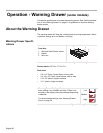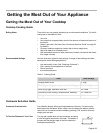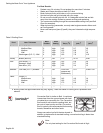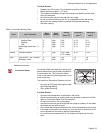
English 29
Getting the Most Out of Your Cooktop
Cooktop Cooking Guide
Boiling Water Time to boil can vary greatly depending on environmental conditions. Try the fol-
lowing tips to decrease boil time:
• Use a lid.
• Use a pan that is appropriately sized for the amount of water and the size of
the burner.
• Select a pan with a flat base (See “Cookware Selection Guide” on page 29
for details).
• Choose a medium-weight pan (rather than a heavy-weight one).
• Start with water that is already warm.
• Boil the smallest amount of water necessary. Smaller volumes will boil faster
than larger volumes.
Recommended Settings Use this chart as a guide for heat settings. A range of heat settings are listed
because the actual setting depends on:
• type and quality of pan (See “Selecting Cookware”),
• type, quantity and temperature of the food,
• burner used and
• the cook’s preference.
Cookware Selection Guide
Cookware Characteristics Pan selection directly affects cooking speed and uniformity. For best results
select pans with flat bases. When a pan is hot, the base (pan bottom) should
rest evenly on the surface without wobbling (rocking). Flat, medium-to-heavy-
weight pans are best.
To Test the Flatness of Your Pans Turn the pan upside down on the countertop and place
a ruler flat against the bottom of the pan. The bottom of
the pan and the straight edge of the ruler should be
flush against each other.
Getting the Most Out of Your Appliance
Table 3: Cooking Guide
Uses Heat Settings
Bringing water to boil 9 - High
Pan frying, sautéing, browning meat, deep fat frying 6-8 - Med-High
Most frying, eggs, pancakes, slow boil 4-5 - Med
Simmering, finish cooking, covered foods, steaming 2-3 - Med Low
Melting butter and chocolate 1 - Low


















